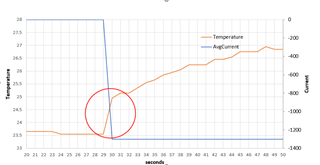Testing the fuel gauge at higher ambient temperatures (~55C) I noticed that the reported external temperature (battery's thermistor) measured by the fuel gauge suddenly increases by 3.5C (in 5sec) when there is a sudden current jump (load increases from ~500mA to 1300mA).
I replicated that jump at my desk at room temperature and found a ~1.5C jump within 1s when increasing the load from 0 to 1300mA.
Probing the thermistor's resistance directly without using the fuel gauge, it all looks reasonable. The resistance slowly drops (battery heating up) when a higher load is applied. Probing the bias voltage and thermistor's resistance with the fuel gauge connected doesn't work because the fuel gauge network seems to be doing something that constantly changes the resistance and voltage. So no reliably reading is possible.
Is that temperature jump normal? Is there a way to minimize that jump, maybe by changing the temp model coefficients of the fuel gauge?


